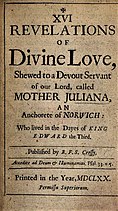| Part of a series on |
| Christian mysticism |
|---|
 |
Revelations of Divine Love is a medieval book of Christian mystical devotions. Containing 87 chapters, the work was written between the 14th and 15th centuries by Julian of Norwich, about whom almost nothing is known. It is the earliest surviving example of a book in the English language known to have been written by a woman. It is also the earliest surviving work written by an English anchorite or anchoress.
Julian, who lived all her life in the English city of Norwich, wrote about the sixteen mystical visions or "shewings" she received in 1373, when she was in her thirties. Whilst she was seriously ill, and believed to be on her deathbed, the visions appeared to her for several hours in one night, with a final revelation occurring the following night. After making a full recovery, she wrote an account of each vision, producing a manuscript now referred to as the Short Text. She developed her ideas for decades, whilst living as an anchoress in a cell attached to St Julian's Church, Norwich, and wrote a far more extended version of her writings, now known as the Long Text. She wrote in Middle English.
Julian's work was preserved by others. Various manuscripts of both the Long Text and the Short Text, in addition to extracts, have survived. The first publication of the book was a translation of the Long Text in 1670 by the English Benedictine monk Serenus de Cressy. Interest in Julian's writings increased with the publication of three versions of Cressy's book in the 19th century, and in 1901, Grace Warrack's translation of the manuscript of the Long Text known as 'Sloane 2499' introduced the book to 20th-century readers. Many other versions of Julian's book have since been published, in English and other languages.



